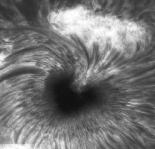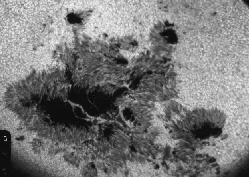
| Sunspots |
 |
| A sunspot |
Sunspots are regions on the solar surface that appear dark because they are cooler than the surrounding photosphere, typically by about 1500 K (thus, they are still at a temperature of about 4500 K, but this is cool compared to the rest of the photosphere). They are only dark in a relative sense; a sunspot removed from the bright background of the Sun would glow quite brightly.
Sunspots develop and persist for periods ranging from hours to months, and are carried around the surface of the Sun by its rotation (a fact known to Galileo). The images on this page show a single sunspot and a complex sunspot group. A typical sunspot consists of a dark central region called the umbra and somewhat lighter surrounding region called the penumbra
 |
| A complex sunspot group. |
Because the Sun is
not a solid body, it does not have a well defined rotational period. Modern
measurements indicate that the rotational period of the Sun is about 25 days near
its equator, 28 days at 40 degrees latitude, and 36 days near the poles. The
rotation is direct, that is, in the same sense of the motion of the
planets around the Sun.